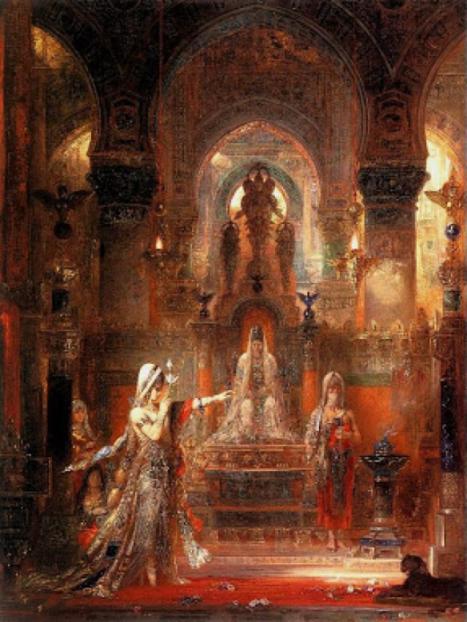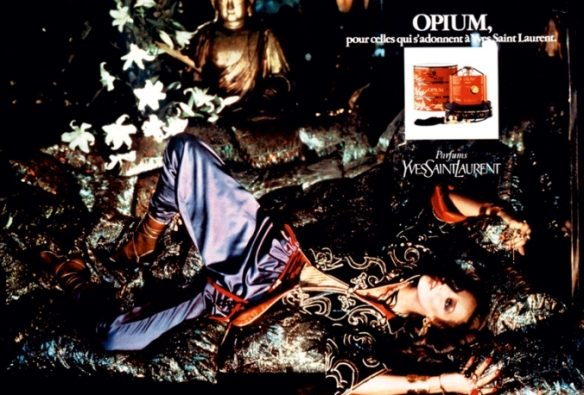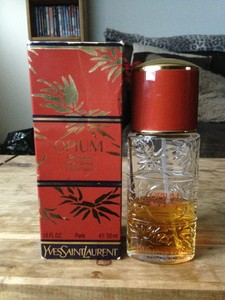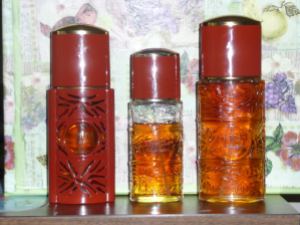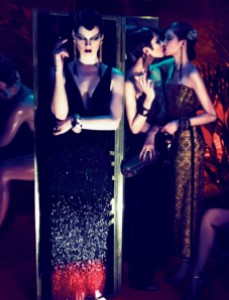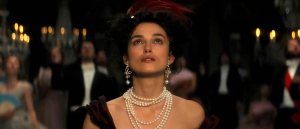Her name would go down in history as one of the greatest temptresses of all time: Salome. But, that night, she was not aware of the infamy which would forever follow her. As she stepped into the palace’s Great Hall, fire burned in her heart; she was a warrior with a mission. Not even the Great Hall could douse the bonfires of spice, smoke, sandalwood, cloved pepper, and molten amber which girded her golden limbs under the misleadingly sweet aura of roses, succulent oranges, heady jasmine, tart plums, and fleshy peaches.
The hall was monstrously large, one vast chamber of onyx marble and gold. Her footsteps echoed as she passed the phalanxes of mighty columns, each one wider than ten men, and festooned with ropes of twisted gold. Rows of tall slaves created a corridor of flickering light, as each one struggled under the weight of a heavy, gold candelabra. The corridor led straight up to the throne, atop a large dias, but the fifteen-foot high, gold-and-jeweled monstrosity was empty. Before it, in a comfortable pile of silk pillows, lounged the King. Herod was too fat to fit into the throne; besides, he thought the bodies of the slave girls festooned around him, and hand-feeding him delicacies, would be a good cover to conceal the excitement that he would undoubtedly show. “She had finally agreed!,” he thought, as his eyes gleamed and he licked his plump lips wetly. The royal court seemed equally excited, chattering nervously about the fame of Salome’s beauty and dancing. They fell silent as she finally drew near and stared at her almost as greedily as the king.
She was a tiny figure, and all but hidden under a mountain of veils. Sheer, in and of themselves, their vast number completely obscured her raven hair and lithe, golden body. Thirty one in all, the veils were ornate, gauzy, in a variety of colours and, magically, made out of the most aromatic, perfumed ingredients: sandalwood ochre, bergamot green; plum purple; orange; blood-red rose; pure jasmine white; chocolate labdanum; dusty clove and cinnamon; the ivory-grey of frankincense smoke; the flesh colour of the ripest peach….
As the music started, she lifted one long arm from beneath the gauzy pile, flexing it like a swan, her long fingers fluttering in the air. Her chin was pointed straight up at that hidden ceiling, miles above, and one shapely, toned, muscular leg swept to the side. Folds of orange gauze glided over her fingers, while clove, cinnamon, frankincense, carnation, rose and bay leaf moved in time with her leg. The swishing of the veils radiated waves of scent out upon the silent courtiers, shimmering flecks of dust that twinkled amber gold in the candlelight. The scents melded together into the most perfect whole, each billowing out like a wave, each one more powerful than the last, until the courtiers swayed to the scent. King Herod forgot to eat, and moaned as he was hit by a tidal wave of spiced sandalwood tinged with heaps of cloves, citrus and cedar, myrrh and frankincense. Rumblings of dry woody notes, bay leaf and patchouli could be heard from beneath the folds of the veils, keeping time to the music as it became faster and faster.

Georges Rochegrosse (French, 1859–1929), “Salome Dancing Before King Herod,” 1887. Joslyn Art Museum
A horde of drummers suddenly appeared, clad in every hue of amber: tolu balsam, benzoin, and labdanum. “Bom, bom….bom, bom, bom…. bom, bom, bom, bom,” their hands moved faster and faster, as did Salome. She stood on one daintily arched foot, twirling in a pirouette of veils, reflecting colours like the jewels glowing on the giant throne. It became all a swirl of notes, a perfect dance of powerful spices atop her silken peach skin, tinged by jasmine that slinked up to the surface from the heat of her body. Unbeknownst to the leering, panting king who watched her, pearls of sweat formed on her rose-tipped breasts, lending a subtle tinge of musk to the floral, citrus, spiced, patchouli amber radiating out from her like waves from the center of a vortex. She danced so fast, frankincense seeped out in white billows, and veils began to fall off her body. One arch of her back, and the carnation veil flew off to disappear atop King Herod’s head. He clawed at it, tossed it to the side in a frenzy of panic lest he miss a glimpse of her body, and the carnation vanished from sight.
For hours and hours, Salome undulated and twisted, swayed and moved, arched and fluttered, until, finally, only seven veils were left. They blended into one beautiful, spiced whole, jasmine and roses on that main base of fiery spices, sweet musk, black smoke and vanilla. The veils just barely covered her lithe, muscular body made from a sinuous mix of sandalwood, patchouli and every possible resinous, balsamic, amber known to man. With a flickering glance at the musicians, Salome suddenly dropped to the ground and the music stopped. There, she slithered like a sexual serpent across the floor, rolling around, and turning in a way that just revealed a glimpse of her musky flesh. As she clawed her way towards the king, she whispered, “Anything my heart desires, your Majesty? Anything in your kingdom? Do you swear it?” Herod could barely breathe. “Yes, yes.” He had no blood flow to his brain. “I have sworn it twice already. I swear it again before the court, may God strike me down if I don’t. I will give you anything your heart desires. Now, please. Finish.”
Salome nodded and, with a single move, was on her feet, swaying with the music that had started again and shedding her veils until she was a blur of naked, ambered flesh. Silky, smooth, creamy, heated, molten flesh — radiating spiced sandalwood, patchouli, endless layers of amber, vanilla, jasmine, and musk. Faster and faster, and faster, she moved until her body dropped in a pile of sinuous limbs. There was complete silence, punctuated by the king’s small moans and shallow breaths as he stared at Salome’s naked body. Still on the ground, she calmly lifted her head, stared at him, and coolly said: “His head. On a silver platter. I want St. John the Baptist’s head.”
The story of Salome is many things but, ultimately, it is a story of a temptress and seduction. It is the story of the lure of sex. And, to me, few perfumes better represent seduction, temptation, tantalizing teases, sex, wild abandon, mystery, and, yes, a warrior’s fiery strength than Opium. YSL‘s magnificent creation is justifiably considered the benchmark oriental, the standard by which all others are measured. (And, in my opinion, the standard by which all others fail to measure up.) It is my beloved, my favorite perfume in the world, my equivalent of Gollum’s “Precious.” As with Gollum, Opium drives me a little mad, but it is also the most empowering perfume I’ve ever worn. I wear it when I need armour and feel like I will be riding out into battle, as much as I wear it to seduce.
I refer, of course, only to the glory that is vintage Opium Eau de Toilette. The current version is a eunuch. It is a travesty which is not even worth acknowledging and which certainly does not deserve the name “Opium.” A complete and utter travesty. Adding insult to injury, there are plans for a future, additional reformulation of Opium already in the works, from what I’ve read, due to EU regulations that will take effect in the next year or so. The present abomination is bad enough; one can only shudder at what will happen when the eunuch is fully dismembered. So, to preempt a wave of tears at the thought of what has already happened to my beloved, and how much worse it’s going to get, let’s focus on the true, real, original Opium.
Opium was released in 1977, the creation of Jean Amic and Jean-Louis Sieuzac. It has a mind-boggling list of notes. Simply mind-boggling. Those of you who wonder why I’m rarely impressed by modern fragrances, well, it’s because most of them have a fraction of the notes present in old vintage classics. And notes equal depth, body, complexity, sophistication and richness. But even a lot of the old classics don’t have as many notes as my beloved. According to Fragrantica‘s listing (which is more for the current version than the vintage), Opium has 31 ingredients, but God only knows how much greater the number is for the vintage version, especially unofficially.
Top notes are coriander, plum, citruses, mandarin orange, pepper, jasmine, cloves, west indian bay and bergamot; middle notes are carnation, sandalwood, patchouli, cinnamon, orris root, peach, lily-of-the-valley and rose; base notes are labdanum, tolu balsam, sandalwood, opoponax, musk, coconut, vanilla, benzoin, vetiver, incense, cedar, myrrh, castoreum and amber.
I don’t like dissecting the notes for my truly, truly beloved fragrances as I generally do. I refused to do it for (vintage) Fracas, and I won’t for (vintage) Opium beyond what I’ve already written above as Salome’s Dance of the (31) Veils. For me, Opium is far too sacred for analysis, far too much a work of art. Plus, it is such a superbly blended masterpiece that a lot of the notes meld and melt into one multi-faceted whole. It’s like the bloody Hope Diamond. It’s just so big, so brilliant, so reflective of so much, but all in one giant piece.
That said, there are definite stages where some aspects shine a little more than others. In the beginning, it’s the burst of orange, infused with seemingly every ounce of fiery, dusty clove and cinnamon available on earth. It’s backed by a hint of plum and peach, but, to me, those notes have never radiated very brightly on my skin. Instead, there are dry woody notes, cedar, a dash of bay leaf, and two different kinds of incense: frankincense and myrrh. Hints of floral notes (especially jasmine) take full sway later, in the middle stage, along with the start of creamy coconut and vanilla. Later, as that phase is winding down, more and more of the amber resins start to dominate: from the more balsamic-heavy, dark, smoky Tolu amber; to the nutty, slightly animalic, minutely leathery labdanum; the sweeter, more vanilla-like tones of benzoin; and what I personally believe is ambergris (but which Fragrantica’s listing for the current version of Opium lists as just plain “amber.”) Opium also has castoreum which is detectable mainly in the dry-down in the slightly animalic leather note. Not a raunchy, harsh, obvious leather, but more of a leather feel like something sumptuously rich, thick, velvety and plush. The sort of heavy velvet that Henry VIII would wear.
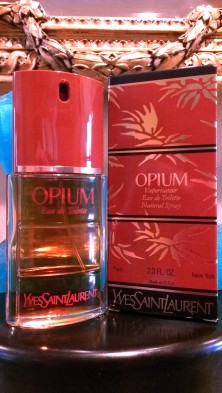
My 1970s bottle of vintage Opium EDT. Note how the box says New York on it and “Made in U.S.A,” in addition to the usual Paris notation.
The problem is that some of these notes and, more importantly, their dominance seem to vary depending on just how vintage your bottle of Opium is. I have two bottles of eau de toilette. The tiny remainder of one from the early 1990s (1992, I think), and a large 1970s bottle which I bought on eBay late last year. It is, oddly and quite unusually, from a short, limited-distribution run when Opium was made in America, not in Paris. Unfortunately, the top notes have gone off, and that evaporation has just concentrated some of the spiced notes to an almost brutal degree. Once, however, you get past the thorny first 40 minutes, the glory of Opium’s base is revealed in full splendour, with gallons (and gallons!) of real Mysore sandalwood. It does not even remotely compare to my early 1990s bottle, though the latter has the benefit of Opium’s always spectacular orange, citrus start being intact.
While I miss that beautiful opening with my 1970s version (due to evaporation of the top notes), I find it interesting to compare the two versions because changes were clearly made in between that have nothing to do with the top notes. My 1970s bottle is a behemoth in sillage and longevity, as was the Opium that I grew up on and which bewitched a seven-year old child to the point of sneaking in sprays from her mother’s tasselled bottle. (Yes, I was an early bloomer, perfume-wise.) My 1990s version doesn’t create an enormous cloud around me at the start, becomes closer to the skin far more quickly, and doesn’t last as long on my perfume-consuming skin. My 1970s bottle clearly has real animal musk — something now prohibited for cruelty reasons. My 1990s version does not, since I believe that the prohibition against natural musk was in place by then. My 1970s version has real castoreum; I can’t smell much of its leathery undertone in the 1990s version. And the 1990s version has weaker undertones, especially the coconut and vanilla of the middle and final stages. In fact, every note is muted in the 1990s version (which should just tell you how bad the post-2000 versions are).
Perhaps the most immediately obvious difference is the huge chasm regarding the spices and the sandalwood accords. Even in the 1990s, Mysore sandalwood was becoming more scarce, and I think there is significantly less of it in my 1990s version than in the 1970s. But the truly overwhelming thing is in the spices, namely the cloves. A while back, I wrote a post centered on a Reuters article about IFRA, the EU and changes to legendary perfumes that have already been carried out, unannounced, often undetected, and definitely kept secret. Raymond Chaillan, who collaborated on the creation of Opium, told Reuters that his co-creation has hugely changed. One reason:
Clove oil and rose oil, which contain a component called eugenol. [¶]… When it was launched in 1977, the original Opium was full of eugenol and also contained linalool, and limonene found in citruses. In large doses, Eugenol can cause liver damage, while oxidized linalool can cause exzema and prolonged exposure to pure limonene can irritate the skin.
My personal (admittedly biased) response: unless one bathes daily and for hours in gallons of Opium, I can’t see anyone spraying enough of the perfume to cause liver damage! Regardless, judging between my two versions, I can absolutely see a sharp drop in the amount of clove, as well as the roses, in the later perfume. And 1992 was far, far before the IFRA/EU regulations of 2008!
As a result, in my personal opinion, the best versions of Opium are from the 1980s, as well as any late-1970s bottles made in France, then any early 1990s version. I think that a 1980s version may have the best chance of keeping the top notes and avoiding evaporation, while still having that 1970s concentration. Obviously, though, it always depends on how a particular bottle of perfume was kept. It’s quite possible that a perfectly preserved, sealed 1970s bottle of Opium that was kept in a cool, dark place would be even better! My bottle was not sealed but was in almost pristine condition — and even so, it suffered. (Then again, it is 36 years old!) As for my 1992 bottle, though weaker than anything from the 1970s, it’s still much, much stronger than what followed it. I’ve read that Opium underwent a reformulation in 1999-2000. In fact, according to a poster on a Fragrantica thread, there may even have been another 1990s reformulation back in 1995! (Remember, the companies were continuously reformulating Opium, in secret, as my 1970s bottle demonstrates). The Fragrantica poster, “Andrapi” writes:
most likely Opium was reformulated in 1999-2000 (as the 99% of fragrances) due to the first wave of so-called “restriction laws”. You can clearly see because the “long-ingredients-list” on the box, became mandatory.
Then; remember before 1995 there was no bar-code : if the box lacks the bar-code, you can date the bottle as a very precious vintage one for sure [.]
More: during years 1995-2004 Saint Laurent batched its perfumes with 4-numbers code on the box and 5-numbers (the previous ones plus “1”) code on the bottom of the bottle (example: on the box 6321, on the bottle 63211. This means: 1996)
Since 2005 to 2011: 1 number plus 3 letters, both on box and bottles (example 7HAA , this means 2007).
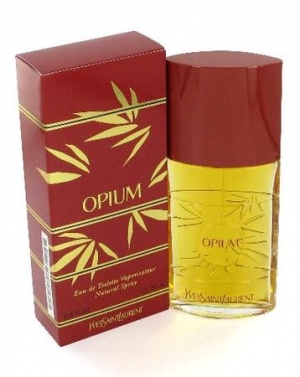
The bastard eunuch version of Opium that is currently on the market. Note the lack of swirls in the glass on the bottle, and the very big difference in the box.
So, let’s say you’re interesting in vintage Opium and are willing to brave the wilds of eBay to get one. How can you tell it’s vintage? Well, if you’re looking to purchase the glass EDT bottles, the best way to tell is by the swirls on the bottle. The new, castrated formulation has hardly any swirls in the glass, as compared to the original one. The box is also hugely different, losing its golden leaves just as the perfume has lost its notes and potency. There are a few threads on the matter at Fragrantica which might help you, starting with this one (which is where I obtained that photo of the three, vintage, glass, EDT bottles shown up above). An even more extensive thread, showing a ton of different bottles, from the pure parfum to various flankers can be found here (in that previously quoted Fragrantica thread).

Yves Saint Laurent, Opium, bottle designed by Pierre Dinand in 1977, photographed by Damien Fry (2011).
Source: Phaidon.com.
As a side note, all this discussion of Opium pertains to the eau de toilette which is the most common, usual form of the fragrance. There is an eau de parfum (as well as a pure parfum extract concentration), but I have the vague sense they were issued a few years after 1977. I am probably mistaken, however, especially as I know my mother had the tasselled, solid bottle (which is usually the shape of the eau de parfum bottle) back in 1977 and that is what is shown in all the adverts from the time. Regardless, the eau de parfum is not my area of speciality, and most of the discussions of “vintage Opium” usually pertain to the eau de toilette concentration. All I can tell you is that, in 2009, Opium (owned at this point by L’Oreal) re-issued the parfum version in what was supposedly a new bottle but which was also, in my opinion, yet another reformulation. Beyond that, however, I’m afraid I’m not a huge help on the issue of the parfum.
As for prices, they vary wildly. On eBay, it is all a question of patience and luck. Create a notification for vintage Opium, check the feedback scores of the seller, and then just pray that someone doesn’t outbid you. You may be lucky and get a small bottle for around $65, or you may be unlucky and end up paying around $150. For the parfum concentration, I’ve seen some sealed, 1 oz vintage bottles go for around $350. Granted, they are parfum and sealed, but it’s still high, even for Opium. Generally, though, whatever you pay, it will still be a lot cheaper than the retail cost of many modern, niche fragrances today, especially if you opt for a smaller size. The glass EDT bottles vary in size from 1 oz/30 ml to 1.6 oz, to sizes like my 2.3 oz bottle or the large 3.4 oz/100 ml bottles. You have to look at the photo of the bottles! The less swirls it has, the more it is absolutely certain that it is a new bottle of the reformulated garbage. Don’t listen to what the sellers say, either; right now, someone is selling a bottle entitled “vintage” which is clearly a post-1999/2000 bottle. (See photo to the right of the modern, reformulated eunuch Opium.) The glass has to be covered by swirls to be at least from the 1990s in age.
One last note, YSL issued an Opium for Men in 1995. It’s been a long time since I smelled it but, based on my recollection of it, it was significantly more muted, more citrus-y, less spiced, and with a very diluted sandalwood base. It’s fine, I suppose. But I wouldn’t bother with it. Men can absolutely wear Opium (original, women’s version), and honestly, I think it’s a thousand times more masculine than some of the unisex fragrances put out today for men. As between a fluffy, saccharine-sweet scent like By Kilian‘s Love (Don’t be Shy) and Opium for Women, I can tell you which one would be a better fit on a man — and it’s not the one that smells of cloying, orange marshmallows! Real Opium would be wickedly seductive on a man, but it would never suit someone used to tamer, milder scents. Opium is a powerhouse, a molten, living, breathing fire dragon that will chew you up and spit you out if you can’t handle her.
Even Luca Turin, the great perfume critic, said: “It is unquestionably one of the greatest fragrances of all time.” While the rest of his Five-Star review (entitled “Spice King”) is a more reflective contemplation on the limits of spicy oriental perfumes due to their focus on the drydown materials, he finally says that he personally tires of Opium:
Opium said one thing and one thing only, with tremendous force. While this was the most cogent statement ever made by balsams [the deepest kind of amber resin], one does tire of it.
Mr. Turin, there you go again. Just when I think I may finally agree with you, you come out with something like that. Well, His Majesty may tire of Opium, but I would shoot myself in the head if I went with some of the other Five-Star perfumes he praises, such as Davidoff‘s Cool Water, L’Artisan Parfumeur‘s Dzing! (which almost drove me to a complete meltdown), or L’Artisan Parfumeur‘s Vanilia which he cheerfully praises for being “vulgar” beyond all limits.
No, thank you, I will take instead what “is unquestionably one of the greatest fragrances of all time” with its 31 glorious notes, evoking raw sexuality, power, and a dragon’s fiery breath. I will keep Opium as my warrior’s shield and sword, as my source of molten ambered invulnerability, and as my means to seduce like Salome. I will wear it, and dance away its 31 glorious veils from sundown to sunrise. Then, when the sky is touched by morning flames of gold and red, I will spray on more of my liquid fire and smile at its secret power. My secret power. My Opium. My love.

